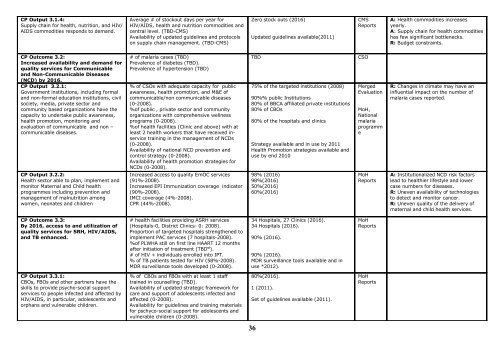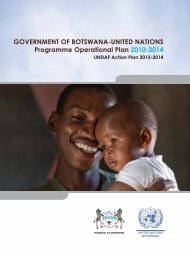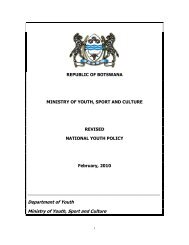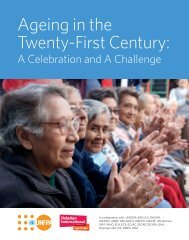United Nations Development Assistance ... - UNFPA Botswana
United Nations Development Assistance ... - UNFPA Botswana
United Nations Development Assistance ... - UNFPA Botswana
Create successful ePaper yourself
Turn your PDF publications into a flip-book with our unique Google optimized e-Paper software.
CP Output 3.1.4:<br />
Supply chain for health, nutrition, and HIV/<br />
AIDS commodities responds to demand.<br />
Average # of stockout days per year for<br />
HIV/AIDS, health and nutrition commodities and<br />
central level. (TBD-CMS)<br />
Availability of updated guidelines and protocols<br />
on supply chain management. (TBD-CMS)<br />
Zero stock outs (2016)<br />
Updated guidelines available(2011)<br />
CMS<br />
Reports<br />
A: Health commodities increases<br />
yearly.<br />
A: Supply chain for health commodities<br />
has few significant bottlenecks.<br />
R: Budget constraints.<br />
CP Outcome 3.2:<br />
Increased availability and demand for<br />
quality services for Communicable<br />
and Non-Communicable Diseases<br />
(NCD) by 2016.<br />
CP Output 3.2.1:<br />
Government institutions, including formal<br />
and non-formal education institutions, civil<br />
society, media, private sector and<br />
community based organizations have the<br />
capacity to undertake public awareness,<br />
health promotion, monitoring and<br />
evaluation of communicable and non –<br />
communicable diseases.<br />
CP Output 3.2.2:<br />
Health sector able to plan, implement and<br />
monitor Maternal and Child health<br />
programmes including prevention and<br />
management of malnutrition among<br />
women, neonates and children<br />
# of malaria cases (TBD)<br />
Prevalence of diabetes (TBD).<br />
Prevalence of hypertension (TBD)<br />
% of CSOs with adequate capacity for public<br />
awareness, health promotion, and M&E of<br />
communicable/non communicable diseases<br />
(0-2008).<br />
%of public , private sector and community<br />
organizations with comprehensive wellness<br />
programs (0-2008).<br />
%of health facilities (Clinic and above) with at<br />
least 2 health workers that have received inservice<br />
training in the management of NCDs<br />
(0-2008).<br />
Availability of national NCD prevention and<br />
control strategy (0-2008).<br />
Availability of health promotion strategies for<br />
NCDs (0-2008).<br />
Increased access to quality EmOC services<br />
(91%-2008).<br />
Increased EPI Immunization coverage indicator<br />
(90%-2008).<br />
IMCI coverage (4%-2008).<br />
CPR (44%-2008).<br />
TBD<br />
75% of the targeted institutions (2008)<br />
90%% public Institutions<br />
80% of BBCA affiliated private institutions<br />
80% of CBOs<br />
80% of the hospitals and clinics<br />
Strategy available and in use by 2011<br />
Health Promotion strategies available and<br />
use by end 2010<br />
98% (2016)<br />
98%(2016)<br />
50%(2016)<br />
60%(2016)<br />
CSO<br />
Merged<br />
Evaluation<br />
MoH,<br />
National<br />
malaria<br />
programm<br />
e<br />
MoH<br />
Reports<br />
R: Changes in climate may have an<br />
influential impact on the number of<br />
malaria cases reported.<br />
A: Institutionalized NCD risk factors<br />
lead to healthier lifestyle and lower<br />
case numbers for diseases.<br />
R: Uneven availability of technologies<br />
to detect and monitor cancer.<br />
R: Uneven quality of the delivery of<br />
maternal and child health services.<br />
CP Outcome 3.3:<br />
By 2016, access to and utilization of<br />
quality services for SRH, HIV/AIDS,<br />
and TB enhanced.<br />
# health facilities providing ASRH services<br />
(Hospitals-0, District Clinics- 0: 2008).<br />
Proportion of targeted hospitals strengthened to<br />
implement PAC services (7 hospitals-2008).<br />
%of PLWHA still on first line HAART 12 months<br />
after initiation of treatment (TBD vi ).<br />
# of HIV + individuals enrolled into IPT.<br />
% of TB patients tested for HIV (58%-2008).<br />
MDR surveillance tools developed (0-2008).<br />
34 Hospitals, 27 Clinics (2016).<br />
34 Hospitals (2016).<br />
90% (2016).<br />
90% (2016).<br />
MDR surveillance tools available and in<br />
use *2012).<br />
MoH<br />
Reports<br />
CP Output 3.3.1:<br />
CBOs, FBOs and other partners have the<br />
skills to provide psycho-social support<br />
services to people infected and affected by<br />
HIV/AIDS, in particular, adolescents and<br />
orphans and vulnerable children.<br />
% of CBOs and FBOs with at least 1 staff<br />
trained in counselling (TBD).<br />
Availability of updated strategic framework for<br />
care and support of adolescents infected and<br />
affected (0-2008).<br />
Availability for guidelines and training materials<br />
for pschyco-social support for adolescents and<br />
vulnerable children (0-2008).<br />
80%(2016).<br />
1 (2011).<br />
Set of guidelines available (2011).<br />
MoH<br />
Reports<br />
36







